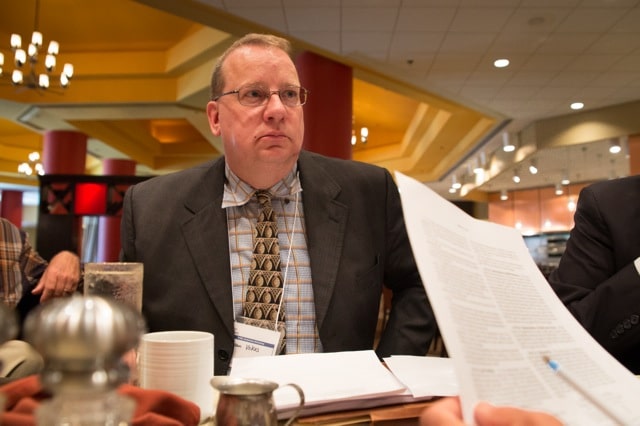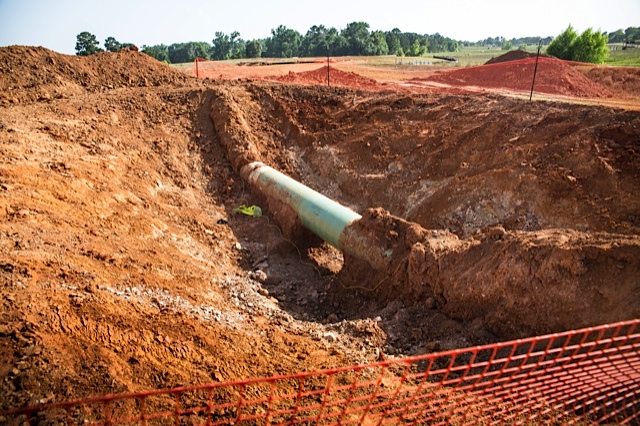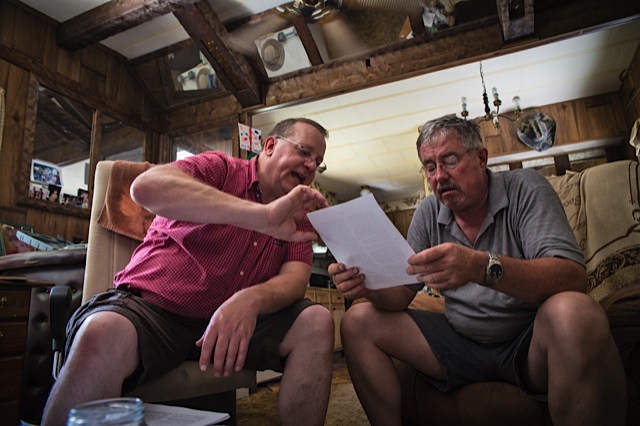Originally published by The Progressive.
Evan Vokes never gave any thought to whistleblowers before realizing he would need to blow a shrill blast against his former employer, TransCanada, the company behind the controversial Keystone XL pipeline. As an engineer he takes his oath to protect public safety seriously.
Like Jeffery Wingand, the former tobacco industry insider-turned-whistleblower, Vokes is motivated by the consequences that industry’s reckless actions can have on society, rather than by any personal vendetta against TransCanada. But Vokes hasn’t had the satisfaction of seeing the insider information he shared have an effect on the pipeline industry, so his work is not yet done.
Environmental groups have been pressuring President Obama to reject the Keystone XL pipeline, a high capacity, high pressure line that would transport diluted bitumen from the Alberta tar sands to the Gulf of Mexico. Tar sands crude is more carbon intensive than conventional crude oil, as well as more corrosive, creating the potential that dilbit will erode pipelines faster. Spills can cause irreparable damage to water supplies, land values and ecosystems.
Vokes, in the pro pipeline camp, has grave reservations about this too. But he is primarily concerned about the pipeline itself, so shoddily built that it may well poison aquifers and harm people’s health. President Obama has told the nation that his decision on the Keystone XL pipeline will be based on whether or not it significantly increases carbon emissions.
Vokes hopes that after TransCanada’s code violations become public knowledge, the President will also give weight to the project’s integrity and address the risks of catastrophic consequences.
TransCanada was already in trouble with Canada’s National Energy Board when Vokes started working for them in 2007. Three court orders had been served compelling the company to comply with pipeline construction regulations they had been caught violating.
Part of Vokes’ job as a pipeline materials engineer was to insure the company complied with the court orders. To comply, the company had to adhere to the accepted codes of pipeline construction set by the American Society of Mechanical Engineers. Straying from the adopted code is not only illegal, it can compromise the integrity of a pipeline.
During his five years with the company, Evan Vokes did his best to get TransCanada to identify and solve its problems. Some of Vokes’ suggested changes were accepted; others were not. Vokes persisted: He urged compliance to regulation to insure quality and safety; however the company continued to emphasize cost and speed rather than compliance.
Despite his efforts on behalf of reform, in 2011 Vokes found himself observing failures in multiple projects, including the Bison pipeline that runs from Gillette, Wyoming to Morton County, North Dakota, and the Keystone 1, that runs from Hardisty, Alberta to Cushing, Oklahoma. Faulty welds, defective parts and rushed preparation for the pipeline installations were causing problems.
The Keystone 1 failed shortly after it began operating, sending an 80-foot oil geyser into the air for 45 minutes until the landowner alerted TransCanada. Twenty one thousand gallons spilled before the line was shut down. An automatic safety feature failed to detect the spill when the line’s pressure started spewing oil. The Keystone 1 had 14 leaks in its first two years of use. Shortly after the Bison pipeline was put into use, it ruptured and suffered an explosion blamed on construction failures.
Pressure mounted as Vokes resisted signing off on flaws which went against his moral fiber and the engineering code of ethics that requires putting public safety before the interests of the company.
When his manager ordered him to stop his investigations in March 2011, Vokes persisted, uncovering an ever increasing scope of wrongdoing. In October 2011, he wrote to TransCanada CEO Russ Girling, offering his own mid-year assessment after Girling welcomed employee input.
” I have to quit or fight,” he told his boss.
“It is with great mirth that I see the quarterly mention of the disappointing project and yet no one at the corporate level makes mention of why did these projects fail and who was held accountable. Instead we see promotion for those that say ‘Yes’ as we make the regulator madder. We task those who were instrumental in the failure with investigating themselves and if you dare speak of what happened it is classed as personal attacks on fellow employees.”
He listed all the things he was trying to do, the positive changes that TransCanada had embraced since he began, and the shortcomings which were still too large for Vokes to accept.
A few days later, he was put on what TransCanada deemed stress leave. Nevertheless, Vokes felt compelled to finish what he started, attempting to remedy the problems from the sidelines.
Vokes sent damning evidence of code violations to the Association of Professional Engineers and Geoscientists of Alberta, the Canadian National Energy Board and to the U.S. Department of Transportation Pipeline and Hazardous Materials Safety Administration (PHMSA).
He was fired when he returned to work.
Though the Canadian National Energy Board has acknowledged the validity of Vokes’s claims, little action has been taken to compel TransCanada to impose corrective measures. Now Vokes blew his whistle in other directions: to the Canadian Senate and the U.S. State Department, to the press, and the landowners directly affected.
For anyone who wants to understand the dangers of a pipeline not built to code, Evan offers a crash course. “There is no worse position than being ignorant of the problems that affect us. I look at education as freedom to achieve and to fend off tyranny,” Vokes says.
Vokes’s actions prompted the Canadian Senate to invite him to participate in their study of the current state of pipeline safety. On June 6, 2013, Vokes testified,
“TransCanada Pipelines has a culture of non-compliance and deeply entrenched business practices that ignore the legally required regulation and codes. The mix of political and commercial interests allows industry to claim they exceed federal requirements when they are building substandard pipelines with no enforcement or accountability in the process.”
He gave the governing body evidence: copies of TransCanada reports, company emails, photos and the National Energy Board’s own court orders that still had not been followed.
On June 11th, the Senate called Iain Colquhoun, the chief engineer of the National Energy Board, and TransCanada’s vice president Dan King to testify, asking them to answer Vokes’ charges. Colquhoun skirted the questions, avoiding many of them. King claimed that since a part of Vokes’ job was to identify any problems, it was only natural that he found code compliance issues. Once they were identified they were fixed, King said, but Vokes’ evidence refutes this position. King also stated, “There is no benefit to TransCanada, financial or otherwise, of cutting corners on safety or compliance.”
But there is. Cutting corners by focusing on speedy construction can substantially reduce construction costs in a very expensive business. No money is made until a pipeline is in operation. It is unclear what the Canadian Senate’s next step will be. Their final report won’t be released until autumn.
In the United States, the Pipeline and Hazardous Materials Safety Administration (PHSMA) has Vokes’ evidence and a mounting pile of reports that detail incidents on the Bison and Keystone 1 pipelines, in addition to anomalies (the industry’s term for defects) found in the newly built southern route of Keystone XL.
TransCanada insists these problems are routine and that they have taken corrective measures. Although TransCanada is fixing mistakes in the field, such defects point to systemic quality control issues. For example, on October 17, 2012, during a mandatory test of Keystone 1, inspectors found a problem serious enough to force TransCanada to take the line out of production for almost a week. TransCanada released a statement describing the problem as a small anomaly. But that claim has not been proven, and there are rumors that a large portion of the pipeline had to be replaced due to a failure in construction that had the potential to cause a major leak. PHSMA has not released information about the cause of the shutdown, despite being repeatedly questioned by journalists.
This spring, the first tests of the Keystone XL southern route detected anomalies. Vokes is not surprised. They’re finding a lot of them since they are caused by not following construction code.
TransCanada spokesman Shawn Howard disagrees. He insists that the increased number of anomalies found is normal since they are building the pipeline to a higher standard than other pipelines, following 57 special conditions they accepted to get this project an initial green light – another claim that remains unsubstantiated.
Site where an anomaly repair was taking place in Douglas Texas (credit: Julie Dermansky)
Vokes testified at a State Department public hearing in Nebraska in April 2013:
“TransCanada keeps insisting the Keystone XL pipeline will be the safest pipeline ever built despite irrefutable evidence to the contrary. In fact they are building the southern portion of the Keystone XL to the lowest permissible standards, just as they have the Keystone 1 and the Bison Pipeline,” he said during an impassioned speech, bringing the audience to their feet.
In June, Vokes visited Texas to attend the U.S. Department of Transportation Pipeline and Hazardous Materials Safety Administration pipeline safety awareness conference and to investigate reports of anomaly repairs on the Keystone XL southern route. He still had hope that the U.S. regulatory agency might act more aggressively than the Canadian National Energy Board. He left the conference discouraged after listening to representatives mislead concerned citizens about the real dangers they will face by having a defective pipeline run through their communities.
PHSMA spokesperson Jeannie Layson told Vokes that PHMSA will no longer be able to refer to the code they are currently tasked with enforcing. President Obama signed the Pipeline Safety, Regulatory Certainty, and Job Creation Act of 2011 into law. Public Law 112-90 says, “Section 24 of the Act requires, within one year of enactment (January 2013), that PHMSA no longer incorporate, in whole or in part, voluntary consensus standards by reference into its regulations unless those standards have been made available free of charge to the public on the Internet.”
This new law goes into effect in January 2014 and essentially deregulates the entire pipeline industry. Since the American Society of Mechanical Engineer code is not available at no cost online, PHSMA cannot insist on currently mandated standards. In 2014, the pipeline industry will have sole responsibility for determining and monitoring their own quality standards in construction.
“The risks they could take for every pipeline in the United States are staggering” Vokes says.
While in Texas Vokes visited some of the directly impacted landowners, explaining parts of the code to them and pointing out how what was supposed to happen differed from what was actually taking place.
On David Whitley’s property where one anomaly was cut out, photos proved the pipeline had been laid in a ditch on top of a boulder, a practice that is not only contrary to code but a sure way to produce a dent.
He also met with activists who have been documenting the repair process and reviewed their images to explain when, where and how the code was not being followed and what the outcome would be.
In a statement to the media, TransCanada claimed they found nine anomalies that would need to be cut out of one 81 mile portion of the pipeline. That figure contradicts the findings of activists who documented dozens of anomaly sites and multiple cut out sections of pipe.
Vokes flew over the area and confirmed that much of the finished portions of the pipeline are now back under construction. He has never seen a project with this many repairs.
TransCanada’s Shawn Howard would not release the actual number of anomalies, nor would PHSMA. Howard stated, ” It doesn’t matter how many sections are fixed as long as they are fixed.”
But again Vokes disagrees. Newly introduced segments of pipe lessen the integrity of the pipeline.
“The new welds required to replace pipe where sections have been cut out, known as final tie-in welds, will be the weakest links in the pipeline, much in the way that a chain is only as strong as the weakest link.”
If the work isn’t done right the second time, no one will know until it is too late. No matter how many repairs are made, the pressure test that proves the strength and serviceability of the pipeline in the first place won’t be done again. A new test is not required after the repair process, Howard confirmed.
Evan Vokes explaining construction code to David Whitley in Winnsboro Texas (credit: Julie Dermansky)
In Beaumont, where the final section of the southern route of the Keystone XL is being installed, Vokes observed new pipeline sections whose coating was already deteriorating. Code requires that the coating on all pipelines must be damage free; the coating is there to protect the pipeline from corrosion.
Burying improperly coated sections potentially creates yet another dangerous shortcoming in the pipeline, currently destined to be put into use whether or not the northern route is approved. The southern route of the Keystone XL will tie into the Keystone 1 pipeline in Cushing, Oklahoma. If the northern route is approved, it will be a short cut with a greater capacity for moving tar sands crude. Even if Keystone XL is rejected, that won’t stop TransCanada from moving tar sands crude from Canada to the Gulf of Mexico.
Vokes was once optimistic that he could help make sure that Keystone XL would be built right. Even if there were problems, he was in a position to change the culture of TransCanada from the inside. But that proved impossible.
He now thinks it is highly unlikely that anything will stop this flawed project. The risks of allowing the project to move forward are great, so he keeps trying to get the information he has already shared with the regulatory agencies out to the public.
“The United States is getting a substandard product, one with an undisclosed number of replacement parts, not a pipeline that exceeds safety standards, despite TransCanada’s repeated claims. Think of it like this: if you bought a new luxury car and it had to go back under warranty because of several major drivetrain problems but they repaired it with used parts, would you have the best car or would you just have a lemon?”
Though his goal of convincing TransCanada to clean up its act has not been achieved, Vokes reflects that at least the authorities that could implement regulations to stop a faulty product from being put into use know the truth. They cannot claim ignorance when things start to go wrong.
Once tar sands spill into an aquifer, it can’t be fixed. You can’t return your pipeline and have the environment restored. There is no lemon law for pipelines.
Subscribe to our newsletter
Stay up to date with DeSmog news and alerts








